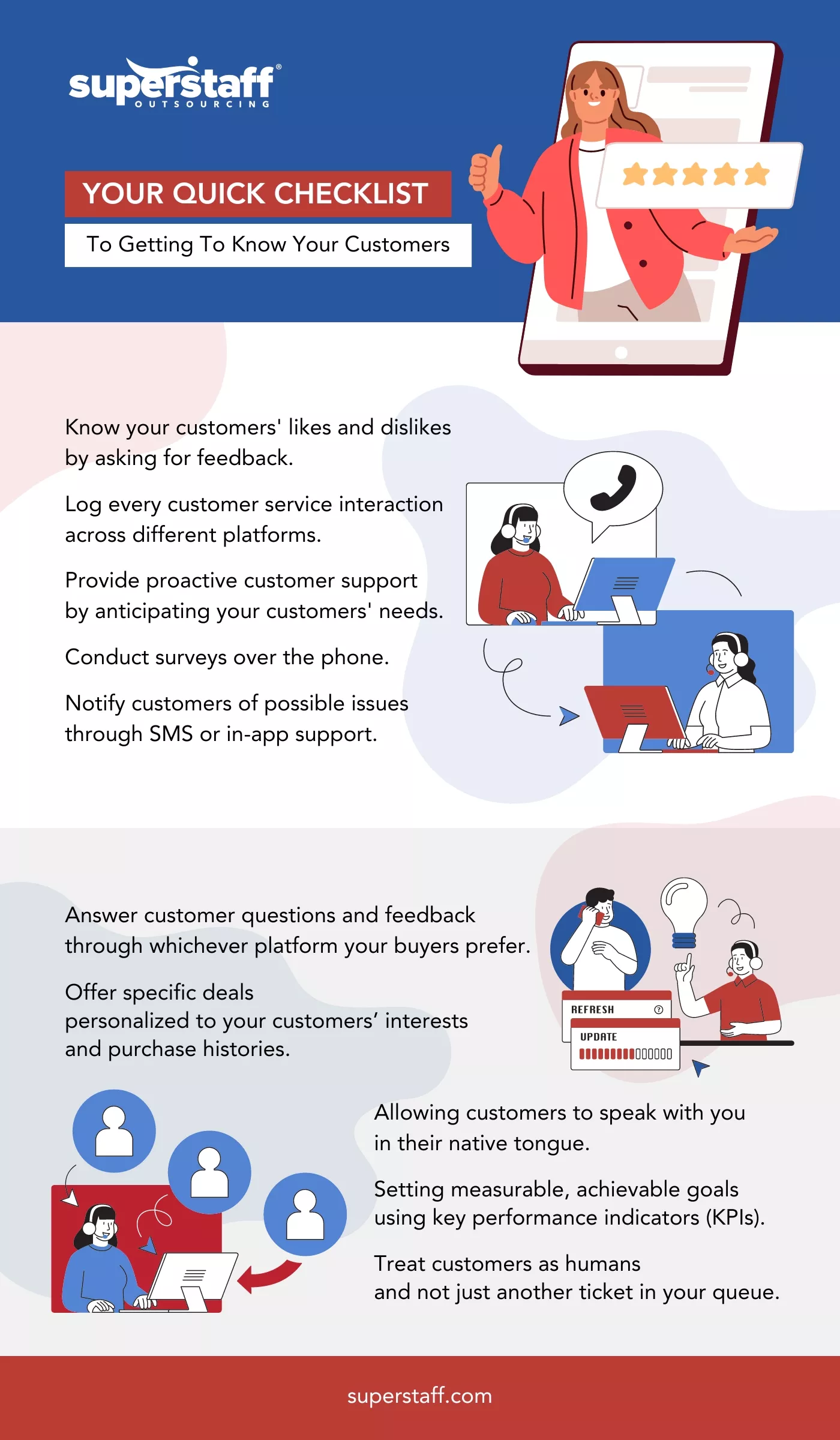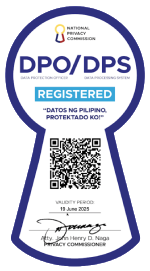
The foundation of every successful business is good customer service. No matter how great your products and services are, many buyers will turn away and never look back if you don’t prioritize customer support.
As such, companies should strive to get to know their customers better and go the extra mile to keep them happy and satisfied.
In honor of Get To Know Your Customers Day 2023, celebrated on the third Thursday of every quarter (in January, April, July, and October), let’s look at how your brand can foster and build better customer relationships.
In addition, we’ll talk about how call center support can help you implement all of these strategies and grow your business.
6 Tips To Build Better Customer Relationships (and How Call Center Support Can Help)
Allow your customers to share their honest feedback.
Customers are more inclined to repeat purchases when a brand offers “excellent customer service.” However, what counts as “excellent” service to your buyers? You can make educated guesses, but nothing beats hearing directly from people who have paid for your products or services.
This is why the first step to fostering good relationships with your customers is to ask for their honest feedback and take the time to listen to what they have to say.
No customer engagement strategy is complete without customer feedback. If you don’t know what your buyers like about your products or services, you won’t know your competitive advantage.
On the other hand, not knowing what customers don’t like will keep you from making necessary changes, improvements, or adjustments, causing your business to stagnate instead of grow.
How Call Center Support Can Help
Have you noticed an increase in product returns or refund requests? Has customer churn increased over the past few months? Your buyers can tell you through the various customer service platforms available.
You can easily track customer service feedback with a customer service outsourcing partner. Every customer interaction, whether through phone, email, social media, or live chat, is recorded and documented at a call center.
Your call center partner can also help you conduct surveys over the phone so that you can directly ask for customer feedback, even from buyers who have not yet been in touch with your support team.

Be proactive in providing customer support.
One mistake business owners often make when it comes to customer service is only waiting for buyers to reach out when they’re already experiencing problems with their products or services.
But the truth is that good customer service isn’t just about waiting for feedback. You should also be proactive in providing support.
In a recent survey, 92% of consumers say they positively perceive brands that offer proactive customer support, and 87% say they want companies to innovate and set new customer service standards.
Providing proactive support means that you must anticipate your customers’ needs (or problems) and reach out to them before they even consider contacting you for assistance.
Examples of this include:
- Being quick to alert customers whenever an issue arises (such as shipping delays, website interruptions, mobile application bugs, etc.)
- Introducing new products or services you think a customer might enjoy (such as having a “recommended products” section in your e-commerce website that updates based on purchase history or sending emails about brand-new discounts and deals)
- Going out of your way to improve customer experiences
One McKinsey study found that about 50% of customers are more inclined to trust companies that proactively disclose data breach incidents than those that hide problems from the public eye.
A different study from Microsoft echoed these findings, stating that 67% of consumers react favorably toward proactive customer service notifications.
How Call Center Support Can Help
To help you better understand your customers’ needs and wants, a call center can also assist you in conducting surveys over the phone. They can help you identify the most common problems your buyers face and collect information and insights that can help you enhance your overall customer experience.
Invest in omnichannel customer service solutions.
In the past, omnichannel customer experiences were seen as a nice perk only provided by some companies. Today, however, it’s become an expectation for any modern company.
Thanks to the accessibility of the internet, people can find your company through a quick Google search. Existing and potential customers can interact with your brand on different channels, from your website to social media and mobile apps.
Adopting an omnichannel approach to customer service means you can answer customer questions and feedback through whichever platform your buyers prefer.
How Call Center Support Can Help
Cloud communication software and other digital technologies allow you to interact and respond to your buyers across all touchpoints.
Offer personalized deals, discounts, and offers.
Personalized support is the secret to building a solid relationship with your customers.
Fortunately, modern consumers have become comfortable with letting companies collect their information and data—as long as these will be used to personalize and optimize their experiences.
Think about it: How would you feel if you received a random, out-of-the-blue email that felt like it wasn’t even meant for you? You’d mark it as spam, delete it, and move on.
On the other hand, if the email you received not only messaged you by name but also offered specific deals and offers that felt relevant to your interests and purchase history? You’d be more receptive to learning about the brand’s new products and services.
When your customers feel that they are being treated as individuals and that you are paying attention to their specific needs, they are more likely to keep doing business with you, with some even becoming loyal to your brand.
Here are a few relevant data and statistics to illustrate the importance of tailored customer experiences:
- 71% of customers expect personalized service and interactions.
- 76% feel frustrated when a brand they like does not provide personalization.
- 71% of people who interact with a customer support team expect teams to collaborate internally so they won’t repeat themselves to multiple agents.
- Fast-growing companies drive 40% more of their revenue from personalization.
By personalizing your customer experience throughout all touchpoints, from the design and UX of your website or app to your support processes to your customer loyalty programs (including email notifications and newsletters), you can help buyers feel seen and understood. Thus, you can help win their hearts and their continued business.
How Call Center Support Can Help
Additionally, call centers often offer telemarketing and telesales services, which help you market your new products or services to existing and potential customers. They can help you make personalized messages and deals for different buyers using customer data they’ve collected.
Provide customer service in multiple languages.
Despite English being considered a global business language, the truth is that not everyone knows or is comfortable speaking with it.
If you run an international business, then it should be a given that you provide customer service in multiple languages, especially the vernacular of your target market.
However, even if your brand caters exclusively to U.S. consumers, offering multilingual customer support can still provide a significant competitive edge.
According to recent data, at least 67.3 million United States residents speak a language other than English at home. Although most may understand English, not all will be comfortable conversing in this language.
Avoid customer frustrations, misunderstandings, or miscommunications resulting from language barriers by investing in multilingual customer support.
How Call Center Support Can Help
Outsourcing multilingual support to capable BPO professionals can help you build strong customer relationships by allowing consumers to converse with you in the most comfortable language.
Instead of assuming that your buyers can voice their concerns in English, allowing them to speak in their native tongue will enable you to have deeper conversations with them, helping you better understand their needs and preferences.
Use KPIs to measure and analyze customer satisfaction.
Let’s assume that you’ve implemented all the strategies mentioned above.
You’ve listened to customer feedback, become more proactive in providing support, invested in omnichannel solutions, opted for personalization, and offered service in different languages.
How will you know that any of these strategies are working on your customer base? Can you be sure that you’re building stronger customer relationships?
Instead of making assumptions or relying on guesswork, your best course of action is setting measurable, achievable goals using key performance indicators (KPIs). Tracking the right KPIs will give you an objective view of whether your strategies are working.
This way, you’ll know whether customer satisfaction levels have improved since trying out a new approach. If KPIs have not changed (or changed for the worse), you can more easily diagnose the problem and make necessary adjustments. Here are just a few of the customer service KPIs you should be tracking:
Customer Satisfaction Score (CSAT)
The CSAT score is one of the most straightforward ways to measure customer satisfaction. This metric lets you know how customers feel about your products and services.
The CSAT score is measured by asking simple questions like, “How satisfied are you with your recent purchase or customer service interaction?” The customer will then give a rating based on a corresponding survey scale (for example, a rating between 1-10, with ten meaning “extremely satisfied” and one representing “not satisfied at all.)
Then, the Score will be calculated by taking the sum of all positive responses, dividing by the total responses, and multiplying by 100.
Formula:
[number of positive responses/number of total responses] x 100 = CSAT Score
What counts as a “good” CSAT score will vary depending on your particular industry. However, a good score is typically between 75% and 85%. A score of at least 75% means that 3 out of 4 customers gave you a positive response.
Tickets Per Customer Per Day
Another way to track customer satisfaction is by taking note of how many customer service tickets are submitted per customer each day. The assumption is that more tickets mean more customers experiencing problems with your products or services.
This metric allows you to gauge your customers’ dissatisfaction and helps you identify one-time or recurring problems that must be addressed.
Although numbers will inevitably vary by industry, researchers found that the average company receives 578 customer service tickets daily. When measured by working hours, the total ticket volume is 6,594.
However, remember that the volume of support tickets may also fluctuate significantly based on several factors, including the times of day or certain seasons.
For instance, some companies may get an uptick in tickets during the holidays because more people are shopping for Christmas gifts. Sometimes, businesses may get more tickets because a newly released product malfunctions.
Tracking the number of tickets and the reason for the increase or decrease in tickets should be your priority. This will help give you a more accurate and complete picture of your customer service situation.
First Response Time (FRT)
First Response Time, also known as First Reply Time (FRT), is a metric that shows how long your company took to respond to a customer service ticket for the first time. This is a critical metric because, according to recent studies, 72.5% of customers want their issues resolved quickly.
So, how fast should your FRT be if you want to nurture good relationships with your customers?
According to a ZenDesk report, “good” FRT rates are as follow:
- Email: 12 hours or less
- Social Media: 2 hours or less
- Live Chat: 1 hour or less
The average FRT is 12 hours and 10 minutes, regardless of platform or industry. However, 75% of customers prefer and expect support teams to answer their queries within 5 minutes.
Average Handle Time (AHT)
It’s not enough to answer a customer’s message. The actual test of good customer service is resolving their problem efficiently.
Average Handle Time (AHT) refers to the time it takes for a support agent to resolve a customer’s problem. AHT is calculated by dividing the total time it takes to close a ticket (including time spent talking, keeping the customer on hold, and following up) and dividing it by the total number of calls.
Formula:
[Talk + Hold + Follow Up] / total number of calls = AHT
Research has found that the industry standard for AHT is 6 minutes and 10 seconds. So, unless your CS team faces a complex and novel problem, your customers will likely expect you to resolve their issue within that time frame.
How Call Center Support Can Help
Your Content Goes Here
Reinvent Your CS Strategies in Time for “Get to Know Your Customers Day”
Are you ready to start turning your once-passive buyers into loyal customers? By leveling up your customer support and engagement efforts, now is the best time to build stronger client relationships.
SuperStaff is a call center headquartered in the U.S., the Philippines, and Colombia. Our experienced team can help you create a customer service strategy that caters to your target market’s unique needs and preferences.
Contact us today, and learn more about our customer service outsourcing solutions!





